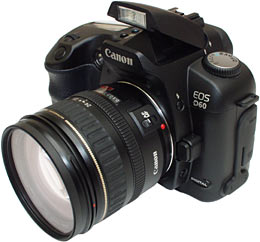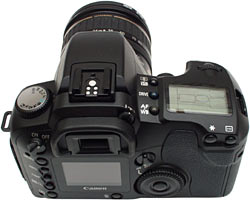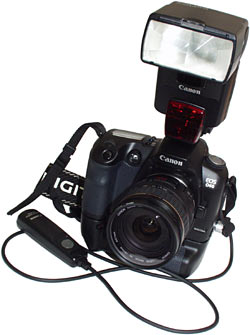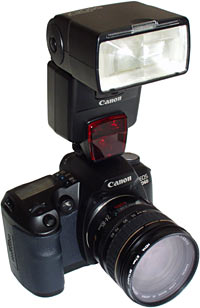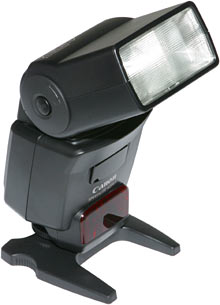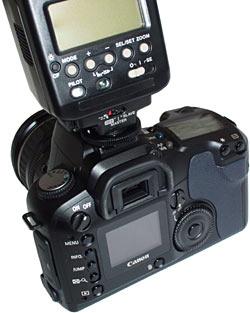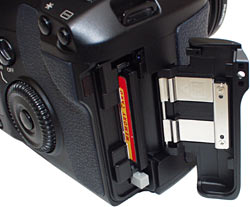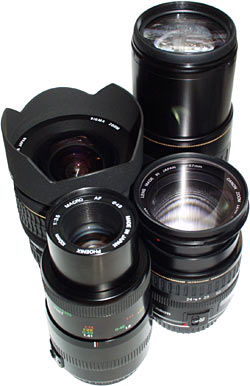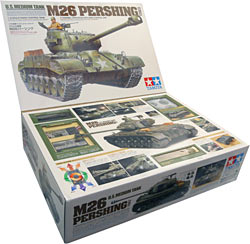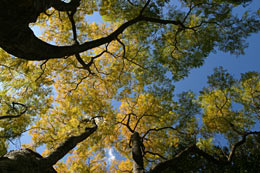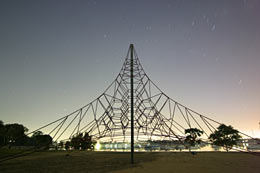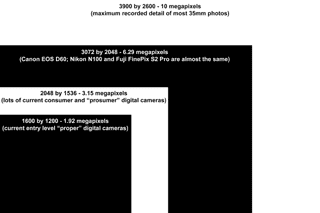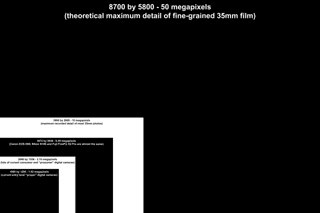
Canon EOS D60 digital camera
Review date: 14 August 2002.Last modified 03-Dec-2011.
For more than two years, my digital camera of choice was an Olympus C-2500L, as reviewed here. The 2500L's still a good piece of gear, and it's more than adequate for most of the photography I have to do for this site. But the need for more features, and the, um, totally defensible desire for a funkier gadget, forced me to upgrade.
This is what I upgraded to.
It's Canon's EOS D60, a proper single lens reflex (SLR) flip-up-mirror removable lens camera that happens to be digital. It's the successor to the already very good EOS D30, and it's a very capable picture-taking object, as you'd want it to be for the $US2200 or so that the basic kit will cost you.
That's without a lens, by the way; the D60 will work with any EF-mount lens (including Canon's own selection, and lots of others), but a few decent lenses will pump the price up considerably more. Skimp on the lenses and you might as well not have bought the fancy camera in the first place.
And then there's CompactFlash memory cards for image storage, and other extra bits and bobs. All of which drive the price of a whole-box-and-dice D60 rig, here in Australia, up far enough that you're more than half way to paying for a basic new car.
I, arguably at least, need this camera. No, really. I do. Honest. Gadget-lust was not a factor in my purchasing decision. Not even slightly. I'm not sitting here fondling the D60 with one hand while I type with the other. Not at all.
Whether or not I need the thing, you, probably, don't.
Digital photography's mature enough now, though, that there is a digital camera out there to suit most photographers. It just isn't this one. In the course of this rather rambling - even by my standards - review of the D60, I'll talk about what different kinds of digitals offer, how film cameras compare, and what matters and what doesn't when you're trying to decide whether to drop the price of a new mouse on a cheerful little baby digital, or a little bit more money on a well-maintained all-manual Leica 35mm film camera with lenses, or rather more again on a modern auto-everything 35mm, or the price of a new PC on a fancy integrated-lens digital, or the price of a good used car on a pro camera.
This isn't going to be the weirdest camera review ever; other people have pretty much sewn up that category. If you just want a straight review of the D60, though, then this ain't it. Phil Askey's review here is what you want. Phil's site is the place to go if you've just hit someone over the head and stolen their nice digital camera, and now need to read a review that's comprehensive enough that you won't miss the manual.
So, assuming that you're happy reading another 100% Genuine Brain-Dump From Dan, let's proceed.
Filthy lucre
I made a serious effort to scam a loaner D60 from Canon Australia, but prolonged correspondence led me to the conclusion that they didn't actually have any cheese at all, at least as far as the D60 was concerned.
Fair enough, really; the D60 is a product that Canon are selling as fast as they can make it. In a situation like that there's no reason for a manufacturer to bother sending cameras to reviewers at all, until production meets the existing demand.
Lenses, Canon could lend me, but I decided to pass on that. They wanted to give me a selection of pricey glass including the monster EF 400mm f/2.8 L image stabilised USM, which is a 6.73 kilogram $AU17,000 behemoth (the second most expensive lens Canon make that isn't available only on special order...) which I'd have to buy a new tripod to even use. If I were into nature or sports photography, or if I were a career pervert, I might have found the thing very appealing. But I'm not, and my fear of dropping it outweighed my desire to play with it.
The upshot of all this is that I (gulp) actually paid for my whole D60 kit. Retail, yet. I feel so ashamed.
The Australian retail price for the D60 is currently $AU5499. For the nice round price of $5199.48, I bought a package deal from DirtCheapCameras here in Australia, which included the standard D60 kit, plus a second battery (the D60's charger has slots for two of its little lithium ion packs, but charges them one at a time), a BG-ED3 portrait grip, and a 192Mb SanDisk Ultra CompactFlash card.
The "Ultra" cards sound as if they should be fast, but they're actually slower than various cheap yum cha CF cards. But the difference isn't crippling, and the price was right. For the battery, grip and memory card I was only paying $AU349 extra; US discounters were charging about $US260 ($AU480 or so, as I write this) for the battery and grip alone. I presume DirtCheapCameras must have rather more BG-ED3s sitting around than they know what to do with.
Incidentally, DirtCheapCameras is the cut-price reduced-catalogue online presence of the Chatswood Impact Camera House store, here in Sydney. You can place an order on the DirtCheapCameras site and pick it up from the Chatswood store, adding stuff that you can't buy online. Well, you can if you're placing a hefty order, anyway; the Impact people are, understandably, less likely to go out of their way for smaller spenders.
I also got a Manfrotto 190PRO tripod (in the US, it's the Bogen 3001PRO) and neat-o grip-action 222 ball head (Bogen 3265). My old tripod was a super-light, ultra-cheap little integrated-head horror from Velbon; the Manfrotto gear is almost alarmingly superior.
If you've got a zoom lens - with or without spooky image stabiliser - and want to be able to use it for anything but very short exposures, you'll need at least one good tripod. I use mine more for close-up product shots, but the principle is the same; lots of magnification means lots of vibration sensitivity.
A rattly aluminium cheapo-tripod is good enough for most digitals, because they don't have enough resolution that the relatively small amount of movement that gets through to the camera matters. Once you've got 3000 by 2000 resolution, though, suddenly there's a reason to get something decent, beyond mere pose accessory collecting.
My Manfrotto tripod's cheap, compared with the real vibration-deadening kings; many photographers drop several hundred bucks on a wooden tripod, which is an excellent choice for muscular people, or those who don't take a lot of pictures on mountains. Carbon fibre tripods are feather-light and also have very good damping, but they're even more expensive than wood. For wind-shake resistance, super-light tripods can be temporarily weighted down with a bag (which you carry with you) full of dirt or pebbles (which you don't); that's the option many mobile photographers take.
My spending frenzy was not concluded. I got an RS-80N3 remote switch (a cable release, basically, but with a three-pin plug instead of a length of bicycle brake cable or a pneumatic tube), and a 550EX flash. And a nice Lowepro bag, which isn't quite as attention-getting as those bags that say SONY or TOSHIBA or something in six inch luminous letters, but which still qualifies as a Steal-Me Bag.
The total price tag (so far) came to about $AU7500.
But at least the camera looked really studly with all those extra bits on it.
The 550EX is a fancy flash which, naturally, integrates with the D60's exposure metering, but which also has full manual control including stroboscopic flash and so on, zooms with your lens, and can also be used as a separate slave flash. Put a 550EX on your camera, and more compatible flashes nearby on the little stands that come with them, and you can trigger the others along with the master one; they communicate via infrared. The IR transmitter fires through the flash lens and has a range of ten to 15 metres.
Fortunately, your slave flashes don't have to be the expensive 550EXes. The cheaper 420EX ($US180-odd, versus $US330-odd for the 550EX) can work as a wireless slave, but not as a master...
...and it, naturally, also comes with a little stand. As a slave flash, It only works in E-TTL ("Evaluative-Through-The-Lens") mode, which is the top-end auto-exposure mode that works fine most of the time but doesn't let you set the flash output manually. But you can still adjust output, change the flash ratio for fill flashes, and set four groups of flashes for each of four available channels, so four photographers can work at once without accidentally firing each others' flashes. And so on. So, for the money, the 420EX is a good piece of gear. I bought one.
There's also a dedicated flashless IR transmitter, the ST-E2. It attaches to the flash shoe on the camera, and lets you use slave flashes without an on-camera flash. You can get the same effect with the 550EX, as it's possible for it to work as a master without firing its own flash. If you don't want the expense of the 550EX and/or the big lump hanging off your camera, though, the ST-E2's an elegant solution.
The design of the D60 makes it impossible to use the camera's built in flash and the hot-shoe flash at the same time, for direct-plus-reflected lighting. I did two-flash pictures with the C-2500L all the time, but the D60's big flash sits on top of the built in flash and stops it from opening. Fortunately, the slide-out, flip-down diffuser on the 550EX can be slid out but not flipped down, so it stands up as a partial reflector and gives you some forward light, while still letting you bounce most of the flash off the ceiling, or whatever. If you want something more omnidirectional, a simple clip-on diffuser like a Sto-Fen Omni-Bounce will do it.
192Mb isn't actually that big a memory card when you're plopping 2.5Mb images onto it, so I bought a 512Mb Ritek card as well, to go with the 256Mb Ritek I already had. The new card cost me less than $AU450 delivered from an Australian eBay vendor. The D60 works with MicroDrives as well, of course, but I prefer something that's less likely to die if you drop it.
In maximum quality JPEG mode, the D60 can jam more than 190 exposures on a 512Mb CompactFlash card - well over five 36 exposure rolls of film. Or twice that many, on a 1Gb Microdrive or thrillingly expensive memory card of the same capacity. Swapping cards is the work of a moment, as is dumping the data on one to a computer; use a fast enough card reader/writer (which is to say, not a USB 1.1 one) and you can suck all 487Mb of data off a "512Mb" card in less than two and a half minutes.
The D60 also has USB connectivity of its own, but it's only USB 1.1, so there's no speed advantage.
You can use the USB connection to update the D60's firmware as well as transfer images, but you don't have to. You can just stick the firmware update file on a CompactFlash card, put the card in the camera and turn it on; then there's a simple interface where you select a few OK buttons, and a writing period, and then the job's done. If you get a D60 that doesn't have at least the v1.0.2 firmware, you should update it, primarily to fix an underexposure problem.
You can download the updated firmware here. Software updates are downloadable here.
My "512Mb" CF card only has an actual capacity of 487Mb because, mainly, of the old powers-of-ten versus powers-of-two rip-off. Storage manufacturers, including hard drive companies, almost always define a megabyte to be 1,000,000 bytes and a gigabyte to be 1,000,000,000, while your computer says they're 1,048,576 and 1,073,741,824 bytes, respectively. Every time I think about this that vein on my temple starts to throb, though, so let's move on.
Types of digital camera
There are a lot of other digital photographic options. Most of them won't require you to sell your immediate family to afford them.
There are four main categories of dedicated digital still cameras - as opposed to camcorders that can take still pictures, and other such oddities.
First, there's toy cameras. It's actually a bit mean to call these things toys; they do take pictures, and they can take very good ones in the hands of someone who knows how to use them. But they don't have a lot of resolution (1024 by 768 at the outside, these days, and more commonly 640 by 480), seldom have a flash, never have a zoom lens or a screen on the back for you to review your pictures, generally have lousy optics, and very probably don't have removable storage either, so you're stuck with however much memory is built into them. Toy-digicam prices start well below $US100, and for the money, they're often great little gadgets. But general purpose cameras, they are not.
Then, there are consumer cameras, costing from a couple of hundred US dollars to around a thousand. To make it into this category, a camera must have a flash and a screen on the back for image reviewing, ought to have removable storage and a zoom lens (digital zoom that just crops out the middle of the image doesn't count), and really should have autofocus as well; I talk about the limitations of "focus-free" lenses in my old camera review here.
A consumer camera is all that most people need, and it can be a handy adjunct for a pro photographer as well - a lot of pros have now added things like the nicer Nikon Coolpix models to their camera bags.
Next, there are "prosumer" cameras, which don't have the full feature sets that professional photographers want from their main cameras, but which can be used for a lot of pro photography nonetheless. There's no really clear line between consumer and prosumer cameras, but prosumer models generally have all of the possible consumer camera features, more resolution, higher quality lenses, more zoom, and various other extra bells and whistles. Prices range from below $US1000 to the thick end of $US2000. Prosumer digicams don't have removable lenses, but, at a glance, you could be forgiven for assuming that some of them did.
My C-2500L was a prosumer camera when it was new. Now, there are entry-level consumer digitals that can beat the 2500L in several departments, and current prosumer cameras are way ahead of it.
Buying a consumer or prosumer digicam is, in many ways, like buying a point-and-shoot film camera. You get a camera. It's got a lens on it. That's the only lens you get. It probably has half-decent zoom, it probably has a perfectly acceptable maximum wide angle setting, it probably has OK close-up capability. It will have more distortion and chromatic aberration than a separate lens for a more serious camera, but most photographers aren't likely to notice the difference, and the whole integrated-lens camera may cost quite a lot less than a mere lens for a camera like the D60.
There are plenty of worthwhile extras you can buy for an integrated-lens digicam - more batteries, a cheap tripod, maybe an external flash, maybe screw-on filters and wide-angle adapters and teleconverters - but you'll have to try pretty hard if you want to spend the price of the camera again on all that stuff.
You will face no such problems if you buy something in the last digicam category - true professional digital cameras. When you get a pro digital, whole new money-eating vistas open up.
Pro digicams generally look like high-end 35mm cameras, and accept the same lenses. The image sensors in pro cameras are almost all smaller than a 35mm film frame, though, so they can only see the middle bit of the image from the lens. This gives them a "focal length multiplier"; whatever lens you use will behave as if it's more telephoto than it is on a 35mm film camera. The smaller the digicam's sensor, the bigger the multiplier will be. The EOS D60's focal length multiplier is 1.6, so a "50mm" lens on the D60 will give you the same field of view as an 80mm lens on a 35mm film camera.
The Contax N Digital (which currently costs around $US7000) has a full-35mm-frame-sized sensor, and other pro cameras will no doubt have them in the future. But focal length multipliers are still the norm.
Pro digitals don't come with a lens. All you get in the standard kit is the camera body, to which you can attach a variety of lenses, just as you can with normal 35mm SLRs.
You can easily pay the price of the D60 again for a lens. Heck, you can pay four or five times its price, if you develop a hankering for a stabilised super-telephoto suitable for mounting on heavy siege equipment. It's possible to use very inexpensive lenses with cameras like the D60, but it's unwise.
This is partly because the EOS D60 is actually cheap, for a pro digicam, and it lacks a few features that pros often want. But since it's less than half the price of the fancier pro digitals, its shortcomings are forgivable.
Lenses
Because the D60 lets me swap lenses, I can get super-magnified shots, quite extreme wide angle pictures, and stopped-down very-high-depth-of-field long exposures, with minimal distortion. Someone like me who takes a lot of pictures of technological objects, but doesn't have a proper photo studio to take them in, can really use a multi-lens camera.
That's my story, and I'm sticking to it.
The D60's 1.6X focal length multiplier - or "field of view crop", depending on whether you're a glass-half-full or glass-half-empty sort of person - makes lens choice somewhat problematic. The only way to get a really wide wide angle out of the thing is by starting with an amazingly wide angle lens; some sub-20mm oddball-lens which could profitably be used by an old gypsy woman to tell fortunes when you're not busy taking pictures.
So I bought one of those. And some others.
A decent general-purpose selection of lenses for the D60.
The one closest to the camera is a Phoenix 100mm f3.5 macro lens (160mm-equivalent, on the D60), which can manage true 1:1 macro with an included screw on adapter. 1:1 macro means the image on the sensor is the same size as the actual object.
There are Promaster and Vivitar-branded versions of this same lens out there; they're all apparently made by Cosina in Japan. The lens feels like a piece of cheap plastic dung, and it has an autofocus motor that sounds as if it'd be happier driving a slot car. But it only cost me $AU314 including shipping from the States, and it works very well. There are more powerful macros out there, but this'll do.
To the right of the macro lens is the lens I got with the camera, Canon's general-purpose 24-85mm f3.5-4.5 USM zoom, which cost me about $AU650. On the D60, this lens has a roughly 38 to 136mm zoom range, which is enough for most shots, and it's optically good. My old C-2500L has a 36-110mm equivalent lens, with quite a lot of barrel distortion at full wide angle.
The "USM" in the name of this lens stands for "ultrasonic motor", the advanced autofocus motor design that Canon build into their better autofocus lenses these days. The "ring ultrasonic motor" these lenses use is fast, quiet, and safe to push around manually; you don't have to take anything out of gear to use the manual focus ring. There's a cheaper "USM" type that doesn't let you use auto and manual focus simultaneously, though; the differences are explained in this photo.net piece.
My C-2500L, and the 24-85mm lens for the D60, are both wearing UV filters. Not because I actually want to stop ultraviolet light from making it to the image sensor, though. Digital cameras, unlike film ones, can't see UV; they're sensitive to infrared instead. The filter's there because UV filters are about the cheapest ones you can get, and it's not a bad idea to have some does-nothing filter or other on the end of an often-used lens, to protect it. It's an especially good idea to put such a filter on an integrated-lens camera; if you scratch the lens on a point-and-shoot, repairs will probably cost more than a new camera.
And then there's the super-wide-angle lens. It's the funny-looking thing with the permanently attached anti-flare sunshade on it, on the left side of the back row in the lens-collection picture. It's a Sigma 15-30mm f3.5-4.5 zoom, whose 24-48mm equivalent performance on the D60 is quite adequate for sweeping landscapes, close-up shots of relatively large subjects, indoor photos of pretty much everyone in the room, and so on. It's a hefty piece of glass with an old-style whiny-buzz autofocus motor, and an auto/manual focus switch arrangement that requires you to click the manual focus ring fore and aft as well as move a switch, but I nonetheless like it a lot. Which is just as well, since the thing cost me the thick end of $AU1300 landed.
Close-up large-object product-shot example. This Tamiya tank box (the review's here!) is about 68cm (27 inches) wide, and the nearest corner of it was only about 70cm (27.5 inches) from the camera lens.
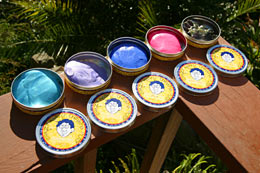
Subliminal message: Buy putty!
At full zoom, the Sigma delivers quite normal-looking pictures...
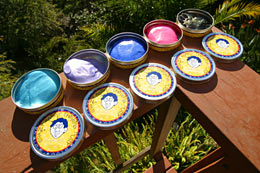
If you don't buy putty, none
of the cool kids will like you!
...but at full wide angle, there's noticeable distortion. It isn't really distortion, but it sure looks like it from normal viewing distances.
Sigma is not a name to conjure with among sensible 35mm photographers. They make a number of less-than-thrilling lenses, including cheap 28-300mm zooms that cost little more than the 24-135mm Canon lens I got. These lenses are popular with people who absolutely can't carry more than one lens, but if you're in that position, you'd probably do better with a cheaper and more compact point-and-shoot integrated-lens camera, since the optics in something with a 10.7X zoom range that costs less than the Amusingly Named Telescope just can't give good results through that whole range.
The 15-30, however, doesn't have a suspiciously large zoom range, and seems to be optically excellent. Like other super-wides, its autofocus performance isn't great on medium distance subjects, but since it can focus down to a foot away, I'm willing to forgive it. On the D60, it also doesn't have vignetting problems; on a 35mm, ultra-wide lenses often produce pictures with dark corners, but the D60's focal length multiplier stops you from seeing that part of the image.
The tall lens at the back of the group in the above photo (quite a long way above, by now) is a Canon 100-300mm f4.5/5.6 USM zoom, which I picked up second hand for $AU300 - roughly half its new price.

At maximum zoom, this unremarkable lens lets the D60 lay this many pixels across the moon.
You can get a lot more magnification than this quite cheaply, if you don't mind ending up with a lens that's not very useful for anything but daylight shooting. For $US110 or so on the auction sites, you can buy a cheap manual focus 500mm lens . A yum cha 2X teleconverter will cost you about as much again. Maybe less, if you hunt around; quite a lot more, if you buy Canon's nicer teleconverter.
If you stick with the cheapo gear then, for under $US250 landed, you can have a rather enormous but half-decent lens (you can get small 500mm mirror lenses, but I speak from experience when I say that those things just don't seem to be able to take one sharp picture) with reasonable sharpness (teleconverters always eat some sharpness, and cheap ones eat more than expensive ones, as you'd expect) and three-and-a-third times as much magnification as a 300mm zoom will give you. 500mm times two times 1.6; bingo, a 1.6 metre effective focal length!
The down side of this is that the light-gathering ability of a cheap-500mm-plus-2X-teleconverter combo is resolutely lousy. You get a fixed aperture of f16, thanks to the lens' f8 aperture and the two full stops added by the teleconverter. Double your zoom, halve the amount of light that makes it to the sensor. But f16 is perfectly adequate for a lot of daylight photography at sensible shutter speeds, and the moon's lit by the sun, so taking pictures of it counts as daylight photography even if you do it at midnight. So with the 1600mm combo, the moon'd be about 1150 pixels wide, and I'd be all set to take spy pictures of celebrities, provided they had the decency to be brightly lit.
If you want even more magnification without spending Astounding Dollars on a truly vast zoom lens with a large-ish aperture, by the way, you can get it by connecting your camera to a telescope. Telescopes meant for astronomy don't necessarily have all that much magnification, though; their purpose is gathering light so you can see really dim things in the sky, not making those things a thousand times bigger.
A great way for film photographers to blow more cash on their lens collection is by picking up some tilt-shift glass. Tilt-shift lenses let you change the position and/or angle of the front lens elements relative to the back ones and the film plane, so that you can eliminate - or creatively accentuate - perspective distortion. These lenses all cost the thick end of $AU3000.
If you want to do this sort of thing the less gadgetty way, you just use a view camera. Which is hardly a pocketable device, but which lets you set the lens to film angle however you like. Digital photographers (and film users who scan their film) have a simpler option, though - image manipulation software. You just use the "perspective" feature in Photoshop (or any other good image manipulation package) to squish the undesirably widened end of the image, and/or stretch the undesirably narrowed end.
The price you pay for doing perspective correction in post-processing is, of course, resolution; squishing throws pixels away, and stretching doesn't create new ones.
That's likely to be tolerable if you're starting with a six megapixel image, though.
Enormous images
In a token nod to digital camera review convention, here come some sample shots from the D60.
There'll only be a couple, partly because I don't want my server to consume more bandwidth than is available in the whole world, and partly because there's really not a lot of point to looking at a bunch of D60 photos, because they just look so darn good. This camera, not to put too fine a point on it, doesn't have any real optical faults. Provided you use a decent lens and the exposure's OK, a D60 photo looks like a film scan.
You can tell a normal JPG D60 shot from an uncompressed drum-scanned film image if you look really closely, but that's because of the JPG compression, not because of anything to do with the image sensor. If you put the D60 in its RAW mode, where images take up considerably more space but have no compression artefacts, then you need special resolution-test cards (which I don't own...) to be able to tell the difference. In the real world, and within its resolution limits, D60 image quality is impeccable.
D60 images have the same 1.5:1 aspect ratio as normal 35mm film. They're 3072 by 2048 pixels in size, when the camera's in its maximum resolution mode. Many digital cameras have a computer-screen-ish 4:3 aspect ratio; there's nothing wrong with that. Different aspect ratios are useful for different things, and medium and large format photographers tend to look down on anything that isn't square. But if you want photos that have the proportions of 35mm film shots, then you want a 1.5:1 camera, and this is one.
D60 images vary quite widely in file size, which indicates that the camera's compression hardware is smart enough to only make big files when it has to, in order to capture extra image detail.
The average file size of D60 images tends to work out at about 2.5 megabytes, in maximum quality JPG mode. This picture...
...on the other hand, is 4.6Mb in size. Lots of leaves; lots of detail.
If you click on the above image, you'll get a 520 pixel wide version. If you want to see the full image from the camera, and you're happy about waiting for the download and winding up my server bandwidth consumption, click here.
There's one thing about the D60 that sets it apart from every other digital camera on the market today, at any price, not counting exotic refrigerated astrophotography cameras. That thing is its long exposure performance.
Digital cameras are, generally speaking, rubbish if you want to take pictures with exposure times of more than a few seconds. This is because the individual cells on their image sensors don't have identical sensitivity.
Over a normal exposure time - 1/60th of a second, say - some sensor cells may be, say, 1% brighter than they should be, for the amount of light they're receiving. Big deal.
Do a one second exposure, though, and the slightly more sensitive cells will now be 60% brighter than they should be, and will probably cause a "hot" pixel in the image. Go up to exposures of about a minute, and even very slight sensitivity differences will cause tons of noise in the final image. The warmer the sensor is, the worse this problem will be; many image sensors are noticeably brighter on one side or corner, which is the part of the sensor that's closer to warm camera electronics. Refrigerating the sensor with a Peltier device or, in extreme cases, liquid nitrogen, can solve this problem; digital astrophotographers do exactly that for their very long exposures of the sky.
If you want a digital camera that doesn't need to be connected to a mains power supply or a frosty pipe, then long exposures are a problem. Many digicams deal with hot pixels by automatically taking a second, shutter-closed picture of the same length as the first one when they're in long exposure mode, and then subtracting that second "dark field" shot from the previous one. The hot pixels in the dark field image will be the same, everything else will be black, and bingo, the hot pixels are deleted. You can do this "dark field subtraction" trick with cameras that don't have such a feature; just manually take a second shot with the lens cap on, and do the subtraction in an image editing program.
Unfortunately, dark field subtraction won't get rid of genuinely random sensor noise, which will always be present. It also doesn't give you back what should have been in the hot pixel spots.
The D60 does not use dark field subtraction.
So far as I can see, it uses magic goblins. Very competent magic goblins.
This, as the star trails in the sky indicate, is a five minute exposure taken with the D60, of a piece of play equipment in a local park in the wee small hours of the morning. The moon was just coming up behind me; it was about as dark as it ever gets in metropolitan Sydney. If you want the full image (only 1.93Mb, thanks to the lower amount of detail in this shot), you can get it here. The image is practically noiseless.
A clean star-trails picture from a digital camera that you can carry around is pretty darn astounding. A bit of back yard experimentation revealed that the no-noise exposure time limit for the D60, at its lowest sensor sensitivity setting of ISO 100, was about fifteen minutes. That was in winter, mind you, with an ambient temperature of around ten degrees Celsius (what passes for cold, here in Sydney). I've now been able to test the D60 on a summer night as well, with an ambient temperature above 20 degrees C; at that temperature, the noise-free exposure time drops to about five minutes.
Neither of these numbers are impressive compared with film, which doesn't have any significant nonlinearity problems at all if your camera doesn't leak light and you're not taking pictures somewhere rather radioactive. But for a digital, five minutes is very impressive and 15 is downright amazing; if your ambient temperature is lower, you may be able to manage even longer clean exposures. 15 minutes at ISO 100 is a worthwhile exposure for astrophotography purposes.
A one hour exposure with the D60 at ISO 100 in winter looked rather noisy - but only about as noisy as an eight second exposure from my old C-2500L.
Resolution
I hate megapixels.
Who the heck thinks in megapixels?
Digital camera marketing people, apparently.
Everybody else who's had anything to do with computers thinks about resolution, if they think about it at all, in plain old pixel dimensions. 800 by 600. 1024 by 768. 1600 by 1200.
Those three resolutions are 480000, 786432 and 1920000 pixels, respectively, which is likely to be 0.5, 0.8 and 2 megapixels, after the marketing people get at the numbers. Such overestimation may just be shameless rounding up, but it's generally thanks to the camera companies quoting the number of pixels on the actual physical sensor, not the number of pixels in the final image written to the memory card. Not all of the sensor is actually used, and the in-camera colour interpolation system may eat some resolution as well. My C-2500L's resolution is a non-standard 1712 by 1368 pixels; the same 1.25:1 aspect ratio as an eight by ten print, and a mere 2.34 genuine megapixels. Or 2.5, according to Olympus' marketing machine.
Fortunately, this resolution inflation is seldom big enough to worry about. The simple use of megapixels at all - particularly their use as a general comparison metric for cameras - is the annoying part.
To get "photo quality" prints from one of the various zooty six-colour ink jet printers that're so cheaply available these days, you need about 200 pixels, or dots, per inch (dpi). More doesn't hurt, less isn't necessarily that bad, but about 200dpi is a good ballpark figure for genuine photo quality. At 200dpi or better, with good paper, current photo ink jets can produce output that's better looking than what you'll get from your local minilab. And which costs considerably more per print, but few digital photographers print everything they shoot, so it can work out as a decent deal, even if you're a penny pincher.
So if you want a normal five-by-seven-inch 200dpi photo, you need about 1000 by 1400 pixels in your image. A mere 1600 by 1200 camera can handle that easily. For an eight-by-ten, you need 1600 by 2000 (3.2 genuine megapixels); a 2048 by 1536 camera will do fine, and you can find quite a few of those for less than $US500, these days. For an eleven-by-fourteen print, you need 2200 by 2800 pixels; now you're getting a bit exotic, and there aren't yet a lot of options. But for poster-sized prints, lower dots per inch values aren't as much of a problem as they are for small prints, because people don't normally look at big prints close up. Relax your standards to a mere 150dpi, and your (relatively) cheap 2048 by 1536 camera will once again pretty much fit the bill.
I wanted to be able to shoot pictures of high enough resolution that they could run full-page in a magazine. For that, I needed roughly 3000 by 2000 resolution. You can stretch lower resolution output as big as you like, of course; look here for a perfect example. A 2464 by 1648 shot from an EOS-1D that ran on a double page in Sports Illustrated (along with a double page D60 shot, in the same issue). This sort of thing is common enough; lots of action shots in magazines are heavily cropped and/or post-processed, and they may have been shot on very fast (and thus grainy) film, or on a digital camera with its sensitivity bumped up to the point where it's got a lot of noise. The picture's the important thing; the quality is secondary. But it does help to have more pixels.
This isn't the end of the story, though; the quality of a picture depends on a lot more than the resolution. Apart from the artistic talent of the photographer, the exposure settings and the quality of the camera's lens have a big impact on the image. My old C-2500L has pretty darn good optics even by today's standards, and takes technically better pictures than various newer consumer cameras with higher resolution output.
Film is the resolution king. It's possible to wring nearly 50 megapixels of resolution (something like 8700 by 5800 pixels) out of a 35mm exposure (36 by 24mm, 1.5:1 aspect ratio), if you're using fine-grained film. To do this, though, you need a really good lens (a non-zoom "prime" lens, or a zoom lens rather more expensive than any of the ones I own), bang-on focus, a very steady camera (or a very short exposure), and a subject that actually has that much distinguishable detail in it. A leafy tree - yes. A clear blue sky - no.
If you meet all of these requirements, it can be demonstrated that film's resolution is up past 40 megapixels. You'll only be able to see that much detail in a well-made print that's at least poster-sized, or in a very well-projected slide, but it is there.
Realistically, though, most "high detail" 35mm shots probably only have about 10 megapixels worth of data in them. 3900 by 2600 pixels, say. You could scan them at a zillion dots per inch and get far more data than that, but you'd just be getting a super-detailed view of the film grain. The actual fossilised light that is the photograph won't manage 4000 by 3000.
The above picture shows the relative resolutions of the current entry-level, mid-range and fairly-exotic digitals, compared with the probable 10 megapixel resolution of film. Click it and you'll get a 1024 pixel wide version; if you for some reason want to see the resolutions actual size, click here, and prepare to scroll around a bit.
Here's the same comparison picture, but this time with the theoretical maximum resolution of film added. Click it and you'll get another 1024 pixel wide version; the rather enormous full-scale version is here. I take no responsibility for any crashed browsers or stalled image viewers that this image may cause.
People who like cameras with a cloth that you flop over your head are scornful of 35mm resolution.
Once again, you need good focus and good camera stability and a subject with sufficient real detail, but assuming all of those, digital's going to take a little while yet to deliver the resolution of a medium format 2.25-by-whatever-inch negative. Five by seven inch large format film can, theoretically, capture well in excess of one billion pixels worth of data.
Mind you, as far as portability and convenience goes, medium format cameras make pro digitals look like something that you can hang on a charm bracelet, and large format cameras are about as user-friendly as you can reasonably expect heavy artillery to be. There are some even larger cameras, but there aren't many of them.
Digital or film?
Soon, there'll be a whole generation of photographers who view film photography as being vaguely icky. Low-tech. Retro. Unnecessarily difficult.
I am a member of that generation already.
I am not, all evidence to the contrary notwithstanding, a mindless new-tech bandwagon-leaper. And I recognise, academically, that film photography is neither difficult nor expensive, generally speaking.
But it just seems so... primitive.
I've taken more photos than a lot of people will in their whole lives. Most of those photos were stunningly boring pictures of products I was reviewing, and most of those photos got deleted, as I scanned through the various differently exposed and angled shots for the ones I wanted to use. But, nonetheless, I've taken a whole lot of photos, and there are a whole lot more in my future, assuming I don't step in front of a bus or make ill-advised comments about Miyamoto Musashi's sexuality in a bar full of drunk Japanese men.
I've only taken a few film photos, though, and that's counting the ones I've taken when someone asked me to take a picture of them with their camera.
Seriously. I've taken, like, eight film photos in my life.
Academically, I'm fully aware of film's manifest advantages compared with digital, as it currently stands. But, personally, if it's not digital then I just don't want to know about it.
I'm not into super-detail wall-filling landscape shots or all-night-long exposures, so the five-to-15-odd minute exposures that the D60 can deliver are enough for me, and six megapixels is enough for acceptably un-crunchy A3-size prints. The absolute maximum "Super A3" print size my Epson Stylus Photo 1270 can manage is 455 by 323mm; 3072 by 2048 wastes a bit of one dimension there (1.5:1 aspect ratio for the picture versus about 1.41:1 for the paper...), but you can still get more than 170 dots per inch, assuming no cropping. Print to full 297 by 210mm A4 size, wasting the same small amount of paper with the aspect ratio mismatch, and you get better than 260 dots per inch. Which is lots.
I'm trying to see the point of view of people who say that "film will be with us for many generations to come", but I really can't quite figure it out. "Many generations" means something like 80 years minimum, right?
OK, I can believe that someone in the year 2100 will still be using film cameras, just as some people today are still using Super-8 cameras and 80 column punched cards. But the idea that ordinary photographers - happy snappers and serious professionals alike - will be using film after I'm dead of old age (or, alternatively, after I've upgraded to a natty cybernetic body to replace my wizened human one) just doesn't make a blind bit of sense to me.
Right now, a decent 35mm body with a decent lens and good slide film can, in the hands of a competent photographer, take a photograph that's technically, and arguably also artistically, superior to the output from any digital system. Sure, no problem.
But, ten years ago, digital couldn't touch film for quality, at any price. Super-expensive scanning back studio cameras had a chance then, and the large format ones are actually better than film now, but they're a small niche. A scanning back works basically like a flatbed scanner, digitising the image one line at a time. It needs quite a lot of light, it won't work with strobes, and it's useless for photographing things that move. So even if scanning backs weren't really expensive, they still wouldn't be any good for ordinary photography.
So, to recap, general purpose digital cameras ten years ago were, as far as quality went, pure manure compared with film.
Now, digitals aren't. They're just somewhat inferior in some circumstances, especially if you want to make really large prints. And they're generally still rather more expensive to buy.
In another ten years, film won't be significantly better than it is now. Film technology is advancing, but only very slowly; it's a mature technology. Mass-market colour film's been around since the 1940s; black and white film cameras of one kind or another are well over a century old.
Give digital cameras another ten years and they will have improved by leaps and bounds. Six megapixel cameras like the D60 will probably be entry-level. 20 megapixel may well be the pro level, with full RGB colour for every pixel (instead of the separately colour-filtered pixels that almost all current digicams use), hilariously huge amounts of onboard storage and/or wireless networking to remote storage, sensor sensitivity above that of the fastest, grainiest film, contrast range up there with the better films, and so on.
If all this hasn't happened in ten years, then I'd say it's an absolute certainty to have happened in twenty, barring the outbreak of World War Three. Not to put too fine a point on it, I'd bet my genitals on this.
Film still with us for "many generations"? Fat chance. Medium and large format film cameras will hold the resolution crown for a while after 35mm's beaten by digital. But even they won't last forever.
People will keep using them, of course, for reasons analogous to those that cause people to still drive Model A Fords. More power to them, I say. But film's still not going to be a mainstream technology, for amateurs and professionals, several decades from now. Digital audio's supplanted analogue pretty much everywhere, and the analogue-enthusiast crowd is rapidly dwindling to just the hard core audiophile metaphysicians; the same thing's going to happen in photography.
This doesn't mean that, at the moment, it's an either-or proposition. Especially if you buy a pro digicam.
If you buy yourself a D60 or some other digital body, you have the option of also getting a half-decent film body to match the lenses you use on your digital. Heck, there's a good chance you already have one or more film bodies, and it's the digital that's the new acquisition, to use with your existing lens collection.
D60 owners who don't have my irrational dislike for film can get themselves an EOS-300 ("Rebel 2000") body for little more than a tenth of the price of the standard D60 package. For that money, if you've got any interest at all in shooting film, why not?
Since 35mm film bodies can be had so cheaply, 35mm film photographers often carry around multiple camera bodies, each bearing a different lens. Pro photographers staggering around at weddings with four cameras hanging off them aren't doing it because each of those bodies has some special feature. All of the bodies may actually be the same, or at least from the same camera family, with the fanciest body on the most often used lens and cheaper bodies on the others. And a spare body in the bottom of the bag, in case one of the others drops dead. The reason for festooning yourself with four bodies, each with a different lens, is to avoid wasting time changing lenses and film.
Many photographers - pro and amateur - love digital, though, because it's so much more convenient for the work they're doing. Pro film photographers are used to going through an amazing rigmarole to produce good images. Test Polaroids. Whole test rolls, when they're shooting a zillion shots for a catalogue or something and need to know exactly what filters to use to get perfect colour balance from the particular crate of film they just bought. The real perfectionists involve themselves in further geekery involving emulsion and batch number and developing process, too.
Studio photographers who are still using film - which, if you want to be able to do gigantic enlargements, is still essential - are quite often using prosumer digicams for their "Polaroid" shots now, and consumer digicams have eaten most of the rest of the instant-photo market. If you're thinking that this might explain why Polaroid has been staggering around like a pole-axed steer for a while now, you're right.
Polaroid actually made some very sci-fi looking digital cameras quite a few years ago, but their only current digicams are unremarkable cheap-and-cheerfuls. The chair has well and truly been kicked out from under them. Part of the reason for that is that digital can remove the difference between a "Polaroid" test shot and a "real" shot.
Even if the photographer and the art person are different people, digital photography lets them confer on the quality of a bunch of shots even as the model stands around in the background - then shoot another bunch, if the first lot weren't up to scratch.
In the photo-enthusiast market segment, the same thing applies. It's a standard piece of advice that the way to take great pictures is to take lots of bad ones. It Is Written, by more than one famous film photographer, that every 36-shot roll of film should contain 35 lousy exposures of the same subject (to demonstrate enthusiasm and persistence) and one good photo (to demonstrate that you're not a total yutz).
Digital costs a lot in the first place, but it lets you carry around several rolls worth of storage (in its perfectly acceptable "HQ" quality mode, my C-2500L can fit at leat 430 images on a 256Mb memory card...), and then shoot all the crummy pictures you like for free. Oh, OK, eventually you'll need to buy new rechargeable batteries, but the incremental costs are trivially small. If you've got the time and the patience, you can take a hundred shots of that pot plant, 80 long exposures of a moonlit statue, 150 shots of the fairground. And then review them with ease, zap the crap, keep the good stuff, go back and refine if you have to, all within minutes.
This is all a thousand miles away from what most people want to do with a camera, of course. For most people, who are neither professionals nor enthusiasts, a point-and-shoot with half-decent specs is still a great idea. In the digital arena, that means something like the Olympus C-2100 Ultra Zoom, which isn't a new product any more but has a ton of zoom, and an image stabiliser, and speedy operation, and a pretty nifty price tag these days too.
The C-2100UZ was good value when I reviewed it (here) in early 2001. Its list price was $AU2299, then. Nowadays, there are eBay dealers with lots of positive feedback who're selling the things for less than $US500, brand new. It's only got 1600 by 1200 resolution, sure, but that's enough for normal photo-sized prints.
The competition
Until the D60 arrived, if you wanted 3000 by 2000 resolution from a camera that didn't cheat by interpolating up the output from a lower resolution sensor, then you were talking Very Serious Dollars. Contax N Digital: Seven grand US. One of the big fat Kodak DCS pro cameras? Well, the DCS 760's the current model, and it costs $US8000; don't expect to pay a whole lot less for a DCS 460, 560 or 660.
Now, though, the D60 is not the only six megapixel $US2000-or-so removable-lens digicam on the market.
There's the Nikon D100, for instance, which as I write this hasn't quite made it to market, but will Real Soon Now. It'll cost about the same as the D60, and arguably has better ergonomics, though the D60's controls are hardly a pain to use. The D100 has better remote control software, for tethered studio use, than the Remote Capture software that comes with the D60. The D100 also has higher selectable ISO sensitivity settings (ISO 1600, 3200 and 6400, which are noisy but still nice to have) than the D60. It's not nearly as good for long exposures and has plain old dark field subtraction noise reduction, but that's about it for the D100's limitations.
And then there's the Fuji FinePix S2 Pro, which uses Fuji's staggered-layout "Super CCD" sensor to get a spectacular maximum resolution of 4256 by 2848. Which isn't as good as it sounds, because the sensor doesn't actually have that many cells, but which nonetheless is genuinely better than the D60 or D100's maximum resolution.
And then there's the upcoming Sigma SD9, which has a Foveon "X3" sensor in it. This sensor can do proper full colour sampling of every pixel. Everybody else's image sensors have a pattern of coloured filters that means each sensor pixel-spot can only actually see one colour; the full colour image is created by cunning interpolation of the coloured-patchwork output of the sensor (my old Digital Camera Data piece says more about this). The Foveon sensor genuinely has RGB sensing on every pixel.
Unfortunately, the SD9 only offers 2268 by 1512 resolution - 3.4 megapixels. The D60 has more than 1.8 times as many pixels.
If chrominance (colour) resolution is important to you, then you could fairly say the Sigma camera has 1.6 times the resolution of a six megapixel camera with a conventional sensor. But if all you care about is luminance (brightness) - and the human eye is much more sensitive to luminance than chrominance - the advantage is much smaller.
If you need to print your pictures big and/or crop them heavily, and maintain decent dots per inch, then the fact that the SD9's pixel count is less than 55% of the six megapixel brigade is likely to outweigh the funkier sensor. High-contrast edges will be visibly "jaggy" on an SD9 image at lower magnification than on a six megapixel image. Plus, the Sigma camera can only accept lenses using the relatively unpopular Sigma mounting system, which greatly reduces your funky-glass options.
The Foveon sensor design may well be what we'll all be using in five years, but right now the SD9 looks likely to be a curiosity only, particularly as its launch price will apparently be $US3000-odd.
Before I decided to buy the D60, I was considering buying an Olympus E-20, which is basically a highly evolved C-2500L, and which can use the same FL-40 flash that I'd bought for the 2500L. It's an integrated-lens camera that looks not unlike a pro digicam, and it's got impressive specs, for a prosumer camera. 2560 by 1920 resolution, for a start.
Unfortunately, as I write this, you won't find an E-20P, the PAL-video-output version of the E-20, for less than about $AU3400. The low price in the States for the NTSC-video-output E-20N is about $US1700 at the moment. That's not much cheaper than the $US1900 the E-20 cost when it was launched more than nine months ago, and it's too much, if you ask me.
The E-20's price includes the integrated lens, at least. A D60 body without any lenses is not a very useful thing, and buying a D60 without at least one good (read: expensive) lens, assuming you don't have one already, is stupid. Drop $AU650 on a proper Canon EF 24-85mm f3.5-4.5 USM and, it, plus a D60, will cost you around $AU5500. More resolution, far more flexibility, blah blah blah, for only 1.6 times the price of the E-20.
Once E-20s (and the earlier E-10s) are commonly available on the second hand and new-old-stock eBay-hawker markets at well under half of their original release price, they'll probably be very good value. I don't think they are at the moment, though.
The pocket-point-and-shoot-to-carry-with-you market has lots of OK cameras in it, if you want film. If you want digital... well, if you don't have specially enlarged pockets, your choice is more limited. Canon's weeny Digital IXUS (or Digital Elph, or IXY Digital, depending on where you live) cameras are definite candidates, and still available new for $US350 to $US500 or so, if you're a good enough bargain hunter. If you can tolerate something bigger, the C-2100UZ still has a lot going for it, as do the Nikon Coolpix 950, 990 and 995. These last three are unquestionably the best value digitals in the world if you want to do macrophotography, and they work fine for regular shots as well. No monster zoom, no light-funnel lens, but you can't have everything.
Archivability
If you're happy for your photos to be ephemeral reflections of the ultimate immateriality of existence, then you're not likely to care very much whether they outlive you. Or, indeed, whether they outlive your current curtains.
Let's assume that you'd like to preserve your pics for posterity, though.
If you want really ironclad archivability, analogue won't give it to you. Neither will any other consumer technology, really.
Analogue photo prints have the advantage that they don't need any other equipment to view them. When our Mars colony declares neutron-bomb war on Earth and annihilates everything from beetles on up, regular photo prints will still be viewable by the conquering retrocolonists.
But all analogue storage is going to lose data over time, and all analogue photo storage methods will do so over human-history timescales, especially if they're looked at frequently. Stone tablets don't, but film does.
Slides fade a bit every time you project them, for instance, and there's no way in the world to duplicate them without losing some quality. A well-photographed 35mm slide that's been kept in a bad climate and projected for a total of six hours is probably still going to contain a lot more image information than a 1600 by 1200 consumer digicam shot, but it's not going to last forever.
Well-stored quality negatives are more than archivable enough for most people's purposes, and ordinary minilab prints in an album may look perfectly acceptable long after everybody in them has dropped dead. The current popular colour photo printing processes aren't made to stay unfaded for decades, though.
Digital has this problem as well, to some extent. If you don't regularly copy data to new media then the old ones can demagnetise or oxidise. It's also been argued that stored media may become unreadable simply because, in the future, nobody will have compatible drives any more.
Storing your digital images, or your digital anything, in some particular format and then sticking the storage device in a military surplus ammo box and burying it in the back yard for 25 years is not a good idea. If you did that 25 years ago, you'd probably now have a buried ammo box full of eight inch floppies or data cassettes or giant hard disk cartridges, which might or might not still be readable by anybody, and very probably aren't still readable by you.
But if you think that it won't be possible to get data off a CD-R in 25 years, I think you're wrong. You, a quarter of a century from now, might not own any gear that could read one of those funny antique 120mm discs. But unless you've used unusually lousy media, the disc still will be readable, and there'll be someone somewhere who'll read it for you for a not-too-ridiculous fee, and who will send you the resultant data. There aren't a whole lot of eight-inch-floppy transfer bureaux out there because there's not much call for them; there will be demand for CD-R reading services. They'll be able to dump the data to microdisc or memory cube or supercard or intangible data cloud or whatever the heck storage system we'll all be using in 2022.
Since you lose no data when you copy digital media, there's no reason not to copy the lot to a new format every five years. For security, copy to several different formats, or at least to more than one copy on one format. Stow one copy under the house, one in the bottom of your wooden chest of drawers (where it's startlingly likely to survive a house fire; assuming your local fire brigade is somewhat punctual, wooden cabinets will be charred but won't have burned through by the time the fire's been put out, while metal ones will be relatively unharmed, but will have passed lots of heat on to their contents), and so on.
Since storage capacity and transfer rate per dollar increase by the month, the total amount of time you'll have to invest in each of your five-yearly copying sessions may well remain the same or decrease, even though the amount of data you're copying is likely to be far, far greater each time.
If you don't insist on having the newest and shiniest storage system every time, data preservation by repeated copying isn't terribly expensive. CD writers and quality brand name media are cheap today; DVD writers will be just as cheap in a few years; Blu-Ray Disc (or whatever) drives will be similarly cheap a few years further on.
It's the photographer, stupid
There's a popular belief, among certain fairly recognisable people, that since cameras take pictures, good cameras must take good pictures. And expensive cameras are good, right?
Cameras, of course, only take pictures in the same sense in which guns shoot people.
Cameras don't take good pictures. People take good pictures. Often, they do that with completely unremarkable cameras. Super-fancy cameras make it possible to take good pictures in more ways, but they also make it possible to get buried in gadgetry and lose sight of your artistic goals, modest as those may be for people doing things like product photography.
Now, if you're larking around with a Holga or a pinhole camera or some other exceedingly low-tech photographic device, then you're likely to take quite technically awful pictures. The same goes for cheap baby digitals. But your technically awful images may still be good pictures.
You don't need an expensive camera to shoot great pictures. You don't need an expensive digital camera to shoot great pictures, either. You can get great results with very cheap digitals, provided you don't need to do things that they just can't do.
If you don't have any pressing reason to get a camera that can do stuff that a point-and-shoot can't, then for Pete's sake don't go buying a D60, or a D100, or any of the more expensive pro digicams. They really won't do a thing for you that a cheap second hand Coolpix 950 won't, except suck money out of your wallet and annoy you when you have to change lenses.
These cameras are also not exactly Mr Convenience. The best camera in the world is no use at all if it's at home in its foam lined almost-everything-proof box at the moment when you discover that the light's hitting the merry-go-round just right. A pro SLR digicam (along with its Steal-Me Bag full of accessories) isn't something that sane people can carry around all of the time. It's big, it's bulky, it's very valuable. Much better to use a little point-and-shoot, if you want a constant-carry camera. And if you don't want to lug a bag of lenses up a mountain, but still want more features than a pocket digital can manage, a prosumer integrated-lens digicam is the way to go.
If you just want the digital equivalent of a disposable 35mm camera, then you want a toy-cam. A Hercules Dualpix (reviewed here), for instance.
The DualPix is going for $AU210 or so, at the moment.
For the price of a D60 rig with the kinds of extras that most people are likely to buy, you could get, oh, about thirty DualPixes.
Now, beyond question, the DualPix is to the D60 as a used motor scooter is to a new Porsche. But if you just want to get from A to B, both vehicles will do it.
If none of the current digicam options appeal to you, just hang around a bit.
Back in the dark distant days of 1996, Kodak's DC50 was a pretty hip and happening consumer digital camera. 756 by 504 resolution with fairly crunchy compression, 3X zoom, storage on expensive PCMCIA memory cards, yours for $US900.
Now, six years later, $US900 will buy you at least eight times as many pixels, fast low-compression image saving on comparatively cheap CompactFlash storage, a far better lens... heck, it'll get you one of these.
In another eight years, the same money will plausibly buy you 6000 by 4000 resolution, really nice glass, and either in-built storage for more pictures than you can take in a week, or some kind of wireless connection to local (backpack) or remote (Internet) storage that gives you functionally infinite picture-taking capacity. And if you just want a simple pocket point-and-shoot with three-by-five-inch print resolution, then you'll be able to get one for a hundred bucks US. For sure. All you have to do is wait.
If you're at the other end of the photographic market from the consumer-cam buyers, you may also be waiting. There are lots of pro photographers who are hanging out for yet more resolution. Something like ten megapixels, so they've got as much resolution in digital as they currently have from 35mm. They won't be throwing away their medium and/or large format film cameras when true 35mm-matching digitals are out, but their 35mm gear will be largely redundant.
Many pros are already using digitals with a lot less resolution than the D60, though. For a lot of purposes, you just don't need six megapixels - or you're willing to give up some resolution in return for easy image transfers.
News photographers love pro digitals, because digital means they only need a data connection to be able to send this afternoon's pics of war-torn Ethniklashistan to the office. For this reason, one or another pro digital is standard issue for photojournalists the world over, and has been for years now, even if they did cost pretty much the same amount as a journo's annual after-tax income.
I, however, am very happy with my D60 and its various accessories. It's pretty much exactly what I needed, and it's a heck of a lot cheaper than this sort of camera was, only a year ago.
My gadget-lust is sated.
For now.
